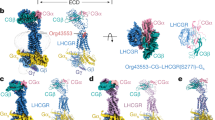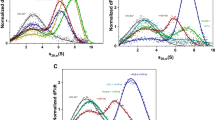Abstract
AT physiological temperatures glucocorticoids1–5, in common with other steroid hormones6, initially interact with normal target cells such as the rat thymocyte by forming hormone–receptor complexes that seem first to be located in the cytoplasm and then rapidly become bound to the nucleus. At low temperatures (0–4 °C) the hormones, when incubated either with target cells or with cytosols from such cells, form ‘non-activated’ complexes that do not bind to nuclei; subsequent warming of the cells1–5, or of the cytosols together with nuclei2,7–11, leads to the formation of nuclear-bound complexes. As shown originally with oestrogens12 and later with glucocorticoids2,7–10,13, if cytosols with non-activated complexes formed at 0–4 °C are warmed to 20–37 °C in the absence of nuclei, the complexes become ‘activated’, and will then bind to nuclei even at low temperatures. Activation, which can also be brought about by increased ionic strength7–9,13, gel filtration, dilution and other treatments14, has been studied extensively and is known to be accompanied by several changes other than enhanced affinity for nuclei. For glucocorticoid–receptor complexes the changes include enhanced affinity for DNA7,10,13–15 and altered mobility on phosphocellulose16, DEAE-Sephadex17 and DEAE-cellulose18 columns. This last property is the one we have used in our experiments. Despite the many published studies on activation, formation of non-activated complexes and subsequent activation have apparently never been demonstrated in cells or cytosols exposed to steroids at normal body temperatures only. Consequently, it is not known whether non-activated complexes and activation have any significant role in physiological conditions, and at least one well known scheme of steroid hormone action19 does not include the activation step. It is therefore possible that when steroid hormones bind to cytoplasmic receptors at physiological temperatures they immediately form activated complexes. The results described here show that for glucocorticoids this alternative can be excluded: when these steroids interact with receptors in rat thymus cells at 37 °C they initially form non-activated complexes, and subsequently give rise to activated complexes.
This is a preview of subscription content, access via your institution
Access options
Subscribe to this journal
Receive 51 print issues and online access
$199.00 per year
only $3.90 per issue
Buy this article
- Purchase on Springer Link
- Instant access to full article PDF
Prices may be subject to local taxes which are calculated during checkout
Similar content being viewed by others
References
Munck, A. & Wira, C. Adv. Biosci. 7, 301–330 (1971).
Munck, A. et al. J. Steroid Biochem. 3, 567–578 (1972).
Rousseau, G. G., Baxter, J. D., Higgins, S. J. & Tomkins, G. M. J. molec. Biol. 79, 539–554 (1973).
Wira, C. R. & Munck, A. J. biol. Chem. 249, 5328–5336 (1974).
Munck, A. & Foley, R. J. Steroid Biochem. 7, 1117–1122 (1976).
King, R. J. B. & Mainwaring, W. I. P. Steroid-Cell Interactions (University Park Press, Baltimore, 1974).
Baxter, J. D. et al. Proc. natn. Acad. Sci. U.S.A. 69, 1892–1896 (1972).
Higgins, S. J., Rousseau, G. G., Baxter, J. D. & Tomkins, G. M. J. biol. Chem. 248, 5866–5872 (1973).
Kalimi, M., Beato, M. & Feigelson, P. Biochemistry 12, 3365–3371 (1973).
Beato, M., Kalimi, M., Konstam, M. & Feigelson, P. Biochemistry 12, 3372–3379 (1973).
Litwack, G. et al. J. biol. Chem. 248, 7481–7486 (1973).
Jensen, E. V., Mohla, S., Gorell, T., Tanaka, S. & De Sombre, E. R. J. Steroid Biochem. 3, 445–458 (1972).
Milgrom, E., Atger, M. & Baulieu, E.-E. Biochemistry 12, 5198–5205 (1973).
Goidl, J. A., Cake, M. H., Dolan, K. P., Parchman, L. G. & Litwack, G. Biochemistry 16, 2125–2130 (1977).
Cidlowski, J. A. & Munck, A. Biochim. biophys. Acta 543, 545–555 (1978).
Atger, M. & Milgrom, E. Biochemistry 15, 4298–4304 (1976).
Parchman, L. G. & Litwack, G. Archs Biochem. Biophys. 183, 374–382 (1977).
Sakaue, Y. & Thompson, E. B. Biochem. biophys. Res. Commun. 77, 533–541 (1977).
Schrader, W. T. & O'Malley, B. W. in Receptors and Hormone Action Vol. 2 (eds O'Malley, B. W. & Birnbaumer, L.) 189–224 (Academic, New York, 1977).
Munck, A. & Brinck-Johnsen, T. J. biol. Chem. 243, 5556–5565 (1968).
Munck, A. & Wira, C. Meth. Enzym. 36, 255–264 (1975).
Erdos, T., Best-Belpomme, M. & Bessada, R. Analyt. Biochem. 37, 244–252 (1970).
Atger, M. & Milgrom, E. J. biol. Chem. 251, 4758–4762 (1977).
Bailly, A., Savouret, J.-F., Sallas, N. & Milgrom, E. Eur. J. Biochem. 88, 623–632 (1978).
Author information
Authors and Affiliations
Rights and permissions
About this article
Cite this article
MUNCK, A., FOLEY, R. Activation of steroid hormone–receptor complexes in intact target cells in physiological conditions. Nature 278, 752–754 (1979). https://doi.org/10.1038/278752a0
Received:
Accepted:
Published:
Issue Date:
DOI: https://doi.org/10.1038/278752a0
This article is cited by
-
Klinische Relevanz von Glucocorticoid-Rezeptoren für die Behandlung lymphoider Neoplasien
Klinische Wochenschrift (1987)
Comments
By submitting a comment you agree to abide by our Terms and Community Guidelines. If you find something abusive or that does not comply with our terms or guidelines please flag it as inappropriate.



